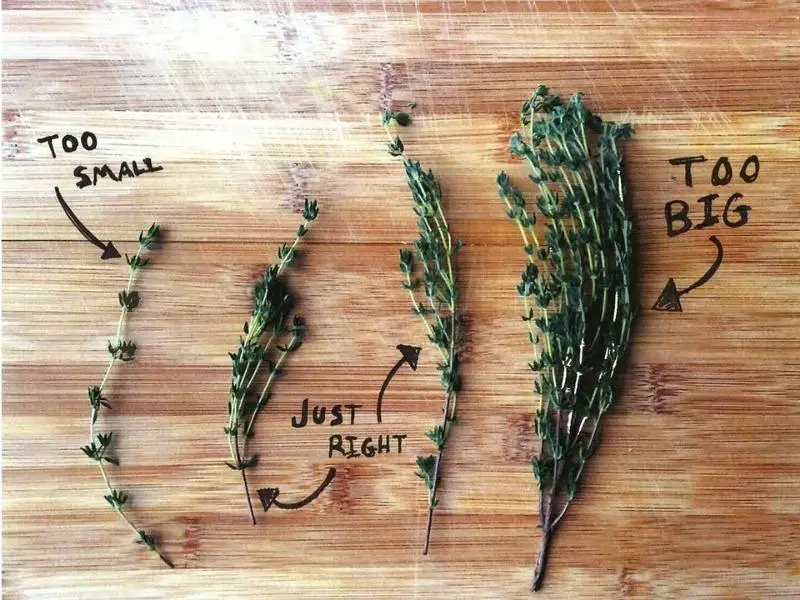- A sprig of thyme is a uniquely shaped kitchen tool. The word “spring” comes from the Middle English word sprygge, which means a shoot or twig.
- When it comes to food presentation, a sprig can make your dish look more appealing by providing color and a fresh garnish.
- Sprigs also have practical uses in the kitchen as well: they are great for adding flavor to dishes that have been cooked or steamed because thyme releases its flavors best when it has been crushed with the back of a knife prior to cooking.
- In addition, if your recipe calls for just one teaspoon of fresh thyme leaves but you only need half of what’s called for, simply pull off the amount needed and freeze the rest in a ziplock bag.
How to use thyme sprigs?
Sprigs of fresh thyme are long, slender stems that have small green leaves attached to them.
The leaves resemble fern fronds and are slightly waxy with an oblong-shaped texture, much like bay leaf or oregano leaf.
However, thyme is not as pungent as oregano so it should still smell nice and fragrant but won’t overpower your dish by making it taste bitter.
>> You may also like: Does Costco Take EBT In 2021? All You Need to Know.<<
Fresh vs Dried Thyme?
You can place the leaves at the tip of your fingers so you don’t bruise them when crushing them up against the cutting board with the back of your knife.
When using thyme leaves, it’s best to use them fresh. However, you can use dried thyme as well if that is all you have on hand.
The only difference is that dried leaves are far less flavorful than fresh thyme so your dish will require more seasoning with salt and pepper to avoid the food tasting bland after adding the dried leaves.
How much is a sprig of thyme?
Typically, one sprig of thyme has anywhere from 4-8 small green leaves attached to it.
You can typically find them at most grocery stores next to the fresh herbs.
If you’re looking for some flavor but don’t want to pay an arm and a leg for one sprig of thyme, look for them at your local farmers market.
>> You may also like: Do Applebees have half-price appetizers in 2021?<<
Fresh thyme vs dried thyme
One bunch of fresh thyme is typically about 3-4 stalks and will cost you between $1-$3.
Produce managers usually place the bunches in a small container to keep them fresh, so be sure to ask if they have any extra sprigs so you don’t have to buy the entire bundle (Photo 4).
The price varies based on region and season because fresh herbs are often quite expensive during the winter months when there isn’t much growing.
Buy one bunch of fresh thyme and get the rest chopped and frozen for later use:
If you can only find dried thyme that is packaged into little plastic packets, the price will be higher than these fresh thyme bunches.
Dried thyme typically costs between $3-$5 for a 1-ounce packet, which is about 2 tablespoons of dried leaves.
>> You may also like: Does Trader Joe’s Take EBT or SNAP Cards in 2021?<<
Substitutes For Thyme Sprigs?
If you need to substitute thyme sprigs in your recipe, use 1 teaspoon of dried thyme or two teaspoons of fresh leaves.
However, keep in mind that the flavor intensity does vary between the two forms of thyme; therefore, you may need to add more for your dish to taste like it does when using one sprig.
What Are The Benefits Of Thyme?
Thyme is a fragrant, perennial herb that has been used for medicinal purposes since ancient times. Some of the health benefits include:
Cough suppressant relief from a dry cough Stimulating wound healing Prevention of cancer Controlling diabetes levels
Lowering blood pressure Antibacterial properties Boosts immune system fights fatigue Anti-inflammatory properties
Prevents bacterial infections Can reduce plaque buildup in arteries Helps with respiratory ailments such as bronchitis and pneumonia.
>> You may also like: Where is jackfruit in the grocery store?<<
What Are The Side Effects Of Drinking Thyme Tea?
If taken in large doses over time, thyme can cause an upset stomach, bleeding problems, and thyroid damage.
What Does Thyme Stand For?
Thyme is strongly associated with the Greek goddess of love, beauty, and sexuality — Aphrodite.
According to Greek mythology, she accidentally dropped some of her magical essences in the ocean which caused it to turn reddish-purple in color.
The air around where this happened smelled like thyme; hence, that is why its botanical name is “thymus.”
Conclusion :
In conclusion, don’t feel overwhelmed when cooking with thyme. It can typically be found in most grocery stores and is inexpensive which makes it a staple herb to add to your favorite dishes.
Just remember that one sprig of thyme has anywhere from 4-8 leaves on it and you can substitute dried thyme for fresh if necessary.

